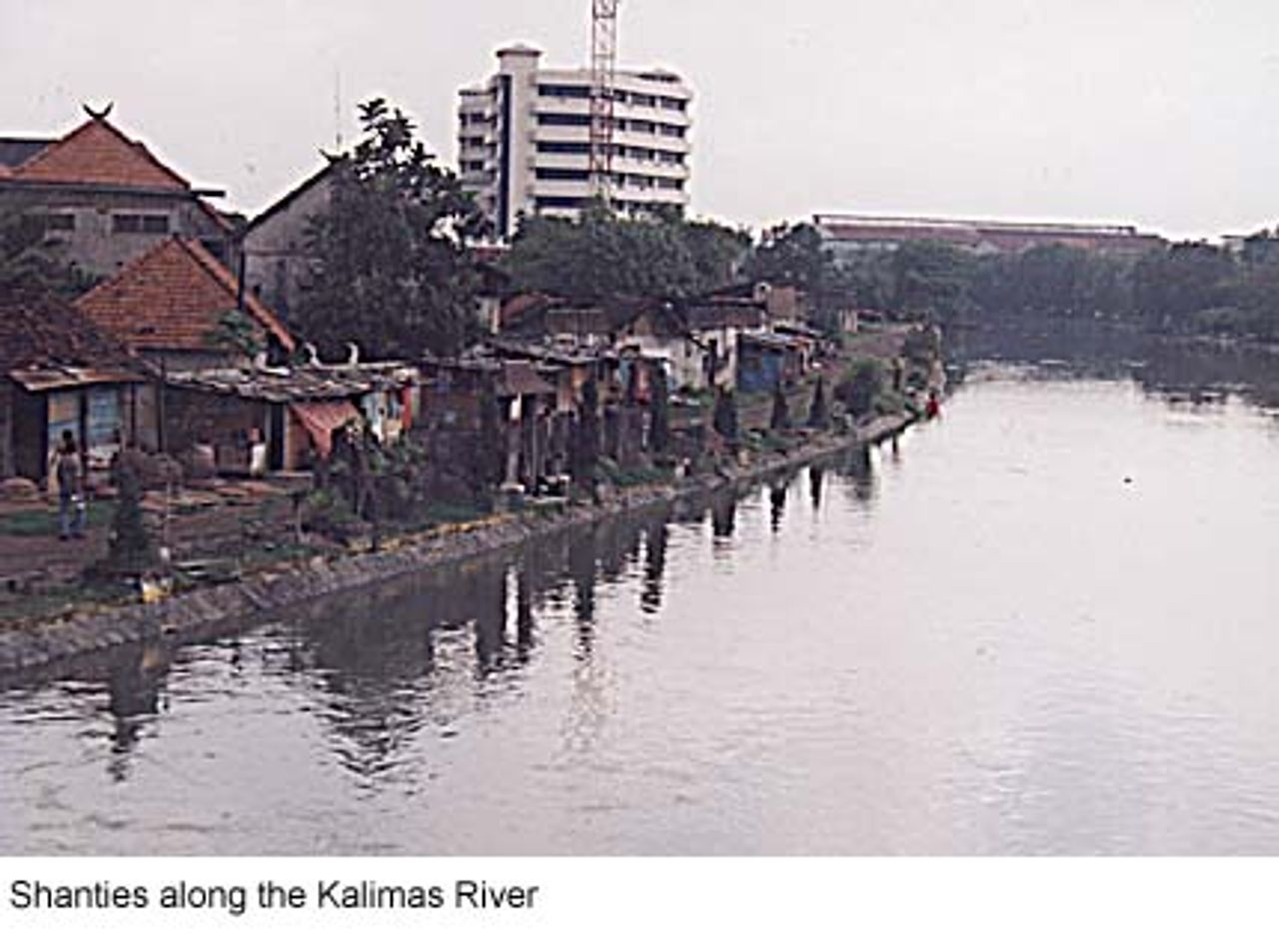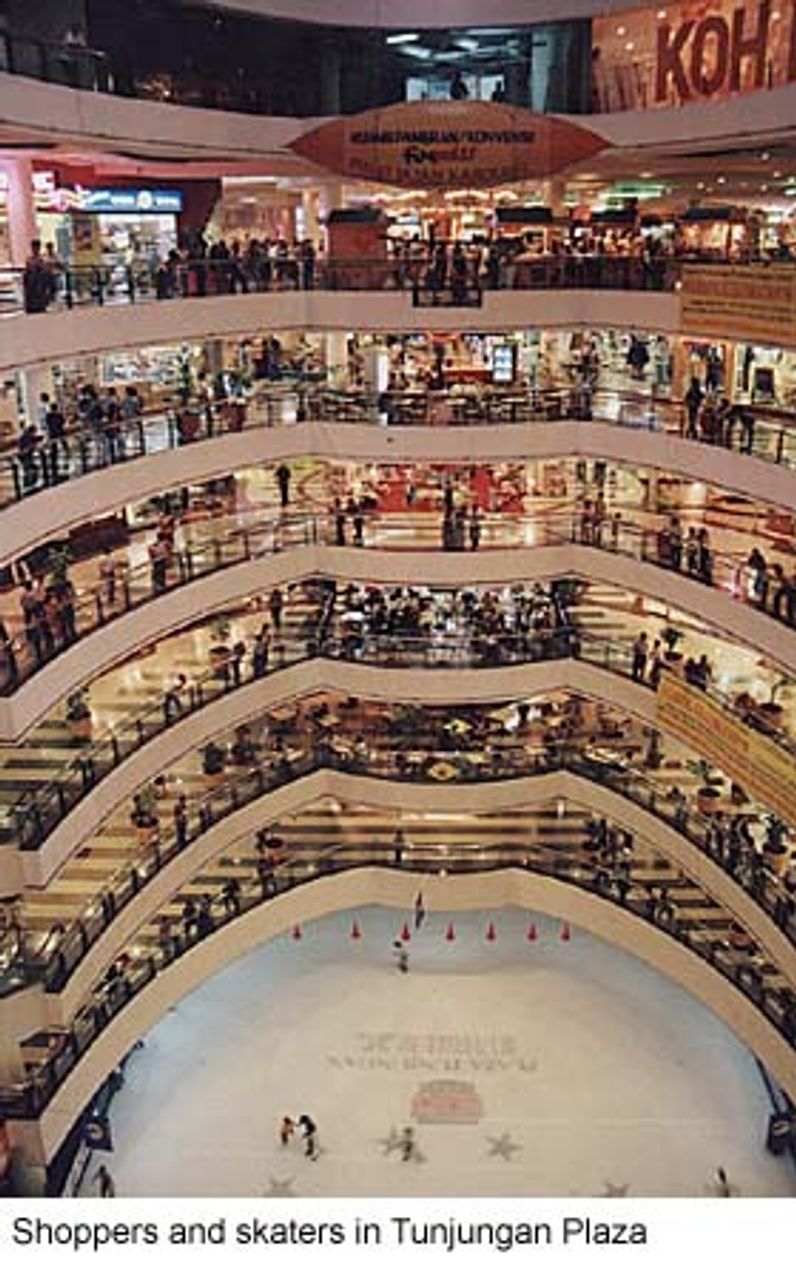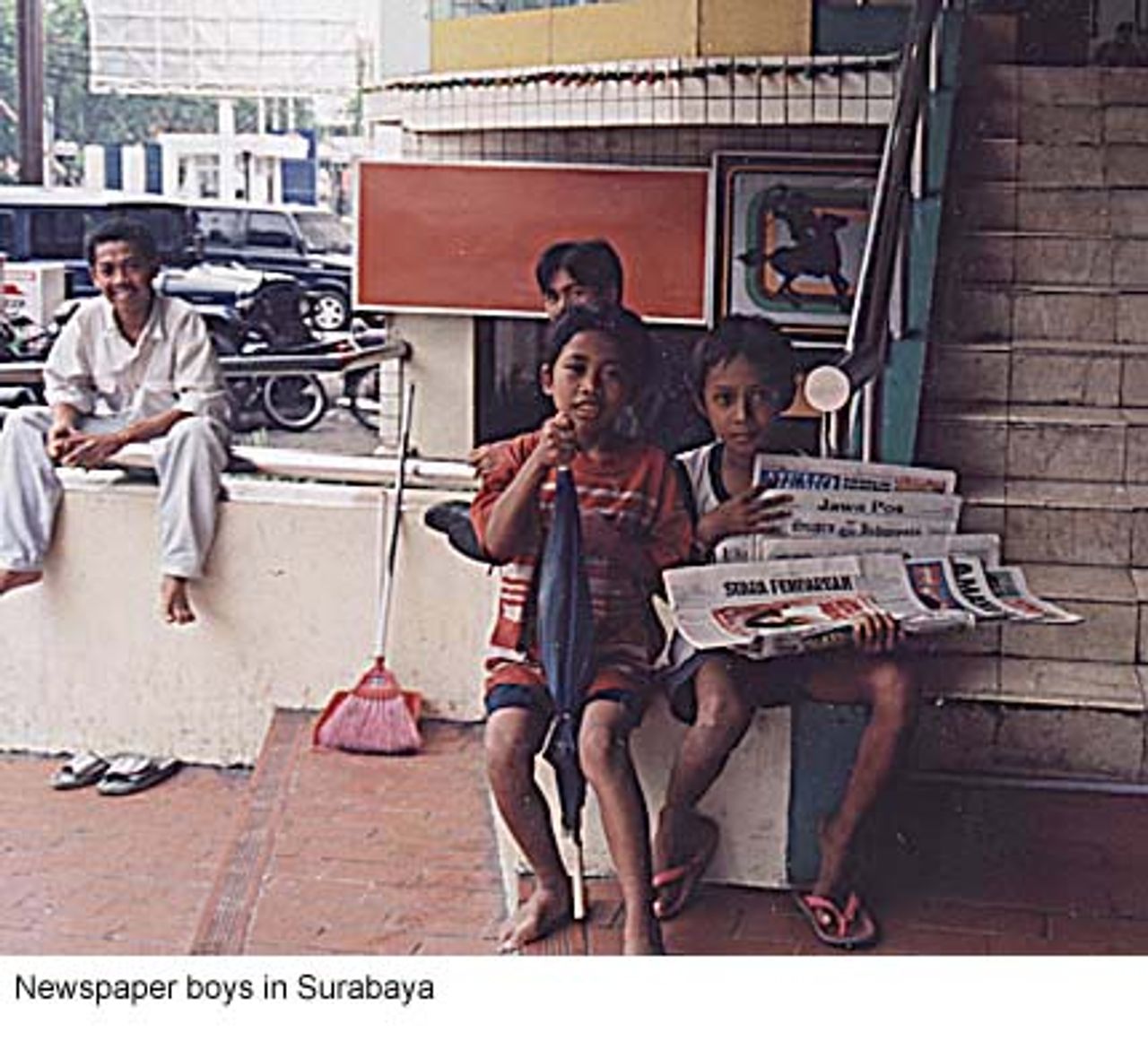Surabaya is a marked contrast with other Indonesian towns and smaller centres. It is a big, busy cosmopolitan city with a population of more than four million--the second largest in Indonesia, a key industrial centre and a major port. Situated in east Java, Surabaya has a history going back centuries as a major trading centre.
What is immediately striking are the tall office towers, the cavernous shopping malls and above all the constant snarl of city traffic. The relentless flow of trucks, cars, buses, mini-buses, motor bikes, bicycles, three-wheeler rickshaws or becaks--all six lanes of it--swells during peak hours and dies away in the evening but never seems to stop.
Here in Surabaya the social chasm between rich and poor is obvious and grotesque. There are more suited businessmen and more beggars. Smartly dressed office workers walk past the drain cleaners who stand for hours in fetid water shovelling slush onto the pavement. School children in crisp new uniforms make their way home while newspaper boys, barely 7, 8 or 9 years old, spend their days on the streets. In select suburbs, the roads are lined with palatial white mansions with carefully manicured gardens. Along the Kalimas River, there are the shanties and hovels of the city's poor.

The stock exchange and solid bank buildings in central Surabaya are a testament to the few who made huge fortunes out of the vast expansion of cheap labour industries as well as the orgy of speculation, corruption and nepotism which characterised the 1980s and 1990s. The hustle and bustle betray little of the financial earthquake that has hit Indonesia over the last year, leading to a collapse of the rupiah, soaring inflation and interest rates, and recession.
A senior official with a state-owned bank was deeply pessimistic about the economic future. With interest rates over 60 percent, he explained, no-one can afford to borrow. Factories using local raw materials and components are still operating but those dependent on imported parts or materials have largely come to a standstill. Although the state banks will probably survive, a lot of the private banks established in the 1980s are now on very shaky ground. Inflation is running at 80 percent according to the government. In reality it is much higher especially for imported items like medicines. Workers simply cannot afford to buy enough food for themselves and their families, he said.
Yet there are many signs of conspicuous affluence--expensive imported cars, expensive clothes, a steady trade at the more exclusive restaurants, and plenty of activity at the Surabaya tennis club. It is the gigantic shopping plazas--great modern day monuments to money, fashionable goods and la dolce vita --that are the real evidence of the city's sizeable middle class.
 Surabaya has at least four of these massive structures. Tunjungan Plaza at the end of Jalan Pemuda was the one I stumbled into on the first day in the city. There must be larger shopping complexes somewhere else on the face of the planet but this Australian reporter has not seen one. Four interconnected airconditioned towers of steel and glass, each rising four to six or seven floors gleaming with chrome and stainless steel, and bulging with shops, banks, boutiques, department stores and restaurants, all with the latest wares.
Surabaya has at least four of these massive structures. Tunjungan Plaza at the end of Jalan Pemuda was the one I stumbled into on the first day in the city. There must be larger shopping complexes somewhere else on the face of the planet but this Australian reporter has not seen one. Four interconnected airconditioned towers of steel and glass, each rising four to six or seven floors gleaming with chrome and stainless steel, and bulging with shops, banks, boutiques, department stores and restaurants, all with the latest wares.
Patrolled by a small army of security guards, the mall is a mecca for the well-heeled of Surabaya. On Sunday, it was packed with shoppers and crowds of youth parading in fashionably labelled clothes who were intent on being seen. The basement in each of the towers had its own particular attraction designed to draw in more customers--in one, stalls with cheaper goods; in another, a dance competition. There is even an ice-skating rink--probably one of the very few that exist so close to the equator.
There were not only window shoppers but plenty of buyers with money. On the fourth and fifth floors, one can sip a cappucino and nibble on gateau while watching the skaters below. The cost of coffee and cake are more than a factory worker would earn in a day. A handful of groceries from the well-stocked supermarkets are worth more than a week's pay for many. The electronic goods and high fashions are the stuff of daydreams for the majority of Indonesians.
Outside the complex, past the security guards and soldiers with automatic weapons, the street presents a graphic reminder of what life is like for most Indonesians. Newspaper boys, beggars and a man displaying a startled lemur are all after a little money from the shoppers. A little further on, a crowd of becak drivers vie for fares of a few hundred rupiah to peddle passengers through the streets in the hot tropical sun. Across the road, a high fence around a vacant lot hides a series of makeshift shanties. Down the road, the drain diggers are still hard at work.

Some 15 kilometres from central Surabaya lies the Rungkut Industrial Estate. As its advertising brochure states: 'With 500 hectares of land, central waste water treatment plant, first class road system, water supply, power supply up to 110 MW, telephones, excellent drainage and sewage, and many more facilities available, this is an Industrial Estate you can rely on.'
Established in 1975, the area is just one of the large industrial estates built on the outskirts of Surabaya. It contains around 350 factories ranging from huge modern plants of such transnationals as Philips and Unilever to modest and even rundown concerns. Each had its own fenced-off compound, security post and guards. The few we approached were very reluctant to show us around--approval from management and even government officials was necessary, we were told.
Tens of thousands of workers are employed in the Rungkut estate. Every morning and afternoon the access roads are clogged with vehicles and bicycles. Many workers live in the surrounding suburbs in tiny concrete boxes which show the signs of aging and disrepair. The shops are small. There are no fancy restaurants or malls. Inside the estate, workers take their meals out in the open from the small roadside food stalls.
What is the average wage of a factory worker? 'Around 7,000 rupiah a day,' my companion tells me, 'and it is not enough. It is 700 rupiah for a bemo (small mini-bus) so that is 1,400 for transport each day. Then you have to have three meals--say 3,000 each. That is 10,400 rupiah just for transport and food. They are going into debt just to survive.'
Inside the bank in the estate's central administrative building, long queues of people--forty or fifty in each--are patiently waiting. They are small debtors, perhaps small businessmen, stall owners or workers, making a payment or seeking further loans.
It is a situation that clearly cannot last. Workers and their families are struggling to get by from day to day.

The bald statistics indicate a fall in real wages of 77 percent and an economic contraction of 14 percent to September 30. Millions have been thrown out of work. At least 80 million people are living below the official poverty line and the figure is estimated to rise to 140 million next year.
Education and health care have become unaffordable luxuries for many. Unable to pay school fees, children have had to leave school to take on small jobs. According to a recent report from the United Nations Children's Fund, only a quarter of the government funds normally allocated for scholarships to keep the children of the poor at school have been disbursed this school year.
Even more disturbing, the report warned of 'a lost generation' as the mental and physical development of today's Indonesian children is affected by malnutrition. 'If you take the average IQ at 100, with 65 percent of children under three years of age anaemic, and 50 percent under two suffering from a lack of micro-nutrients, the average could fall to 92 percent or 93 percent,' UNICEF regional representative Stephen Woodhouse said.
A lecturer in public health confirmed that the hospital system has suffered badly as a result of the economic crisis. 'Many people simply cannot afford to use the hospitals. And the hospitals themselves are suffering from a lack of money,' he said. Newspaper reports indicate that patients are fleeing hospitals in order to avoid paying charges. Tragically a number of mothers have been forced to abandon their newly born children, unable to pay the hospital or to provide for them.
Items from the English-language Jakarta Post provide snapshots of the impact on workers, small farmers and others:
October 16: An official at Purwokerto in central Java reports some 10,000 undernourished elementary school children in 73 poor villages in the Banyumas regency. As an example he cites how over 500 children have resorted to eating rice mixed with cassava. Another spokesman confirms that adults and under-5 children are also undernourished.
October 17: A local eye clinic in central Java blames poor diet and a lack of vitamin A for a sharp rise in eye infections over the last three months from 150 to 1,200 per month. 'This condition is sad because the public are in a very difficult situation in getting good nutrition,' a spokesman said.
October 18: The chairman of the Indonesia Planned Parenthood Association warns that high prices for contraception will force many to drop out of the organisation's programs. The price for contraceptives, which like many other medicines rely on imported products, has soared nearly five-fold over the last year. A small survey is cited indicating that already a number of family planning participants have dropped out for financial reasons.
October 19: A doctor at a hospital in Semarang, central Java, lists malnutrition as one of the causes of the cases of chronic kidney disfunction, which also affects muscles and bones, the nervous system, digestion and sexual function.
An expatriate anthropologist was of the opinion that the full impact of the economic breakdown in Indonesia would not be felt for six months. 'At present,' he told me, 'people are finding ways to get by. They are borrowing money. Some of the unemployed workers are returning to their villages. In the rural areas, farmers are double cropping. But these measures cannot last forever. Sometime next year is when the effects are going to hit.'

Already sporadic strikes and protests have taken place over wage increases, job losses and factory closures, or for demands that employers pay the government's current minimum wage levels. As the social crisis worsens, the level of demonstrations and industrial action will undoubtedly rise. Anger will be fueled by the glaring disparities between the living standards of the majority and the luxury lifestyles of the few.
At Rungkut it is possible to see one of the huge concentrations of industrial workers that are to be found in industrial cities such as Surabaya and the central position they hold in the Indonesian economy. The politics which guide their actions, whether or not they begin to turn to a socialist alternative, will be crucial in determining the political direction of future upheavals.
See Also:
Student protests call for Indonesian president to resign
[30 October 1998]
